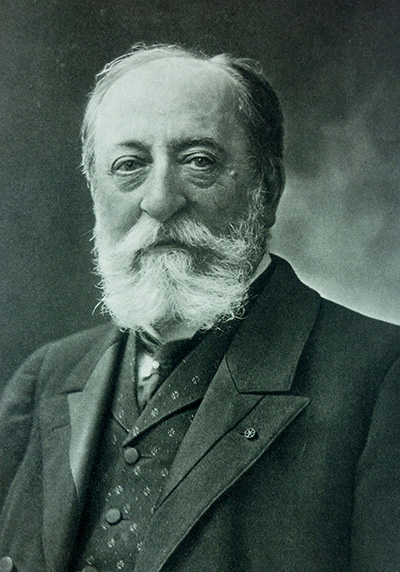Camille Saint-Saëns

- Born: October 9, 1835, Paris
- Died: December 16, 1921, Algiers
Symphony No. 3, in C Minor, Op. 78, Organ
- Composed: 1886
- Premiere: May 19, 1886, Royal Philharmonic Society (then called the Philharmonic Society) in London, conducted by the composer
- Instrumentation: 3 flutes (incl. piccolo), 2 oboes, English horn, 2 clarinets, bass clarinet, 2 bassoons, contrabassoon, 4 horns, 3 trumpets, 3 trombones, tuba, timpani, bass drum, crash cymbals, suspended cymbals, triangle, organ, piano four-hands
- CSO notable performances: First Performance: May 1923 on a May Festival performance with Fritz Reiner conducting (CSO was the house orchestra by then) and Charles Heinroth, organ. First CSO Subscription: January 1939 Eugene Goossens conducting with Parvin Titus, organ. Also, Fritz Reiner conducted this piece on a February 1925 “Pops” Concert with Marcel Dupré, organ. Most Recent: March 2017 for a Tour Preview Concert, Louis Langrée conducting. Other: March 2017 Asian tour, Louis Langrée conducting.
- Duration: approx. 36 minutes
With his third and last symphony, Camille Saint-Saëns set out to write a masterpiece. At 51, he was—and had long been—one of the most famous musicians in France, equally successful as a composer, conductor, pianist and organist. (For many years, he served as the organist of the Madeleine, one of the landmark churches in Paris.) His career had started with the ringing endorsement of such luminaries as Berlioz, Liszt and Gounod, and he had come to be considered a luminary himself.
At the same time, he had reason to feel that some of his best efforts in composition were not sufficiently appreciated. He had won great acclaim for his concertos and other virtuosic concert pieces. However, his symphonic poems, such as Le Rouet d’Omphale (“Omphale’s Spinning Wheel”) met with little enthusiasm in Paris, and his opera Samson et Dalila ("Samson and Delilah"), which was particularly dear to his heart, was premiered, thanks only to Liszt’s unflagging support, in Weimar. At home, Saint-Saëns found himself locked in a bitter rivalry with César Franck, his senior by 13 years. Saint-Saëns was antagonized by Franck’s students and was increasingly isolated in the Société Nationale de Musique, which he had founded. This situation led to his resignation as the society’s president soon after the premiere of the Third Symphony.
Saint-Saëns, then, wanted to make a major statement, and the invitation of the London Philharmonic Society to write a symphony provided just the incentive he needed. He conducted the premiere in London on May 19, 1886, to a standing ovation; the symphony was a success in France as well, when it was performed there. The published score was dedicated to the memory of Liszt, who had passed away on July 31, 1886.
In a program note written for the premiere, Saint-Saëns offered a detailed outline of the themes, described the basic structure of the work, and emphasized his innovations in orchestration. Some of these innovations clearly came from the symphonic poems of his mentor Liszt, who had used the organ in his Hunnenschlacht (“Battle of the Huns”). Saint-Saëns’s method of motivic transformation is also indebted to Liszt.
The traditional four movements of the symphony are telescoped into two parts, with the opening Allegro and the slow movement constituting Part I, and the scherzo with the finale of Part II. Moreover, motivic correspondences permeate all the movements so that the entire work is extremely rich in internal connections.
The main motif on which all four movements are based first appears in the opening Allegro moderato, preceded by a short introduction. The motif is developed extensively, along with a contrasting lyrical idea. It is in the ensuing Poco adagio that we hear the organ for the first time.
In the Allegro moderato that opens Part II, the scherzo (although it is not so labeled), we hear some new variants of our motif. The Trio section, in a faster tempo and in C major as opposed to the scherzo’s C minor, is distinguished by rapid piano scales as a special orchestral color. Both the scherzo and the trio are heard for a second time. Then a short contrapuntal section, based on the main motif, serves as a transition into the finale, which begins with the lush sounds of the organ and the piano (four hands). The main motif is now transformed into a solemn chorale and then into a fugue, where contrapuntal voices imitate one another. The work ends with a magnificent climax.
Saint-Saëns was well aware of the symphony’s significance in his output. He never attempted to write another symphony; instead, he returned to operas, concertos and chamber music. As he wrote about the “Organ Symphony” years later: “I have given all that I had to give. What I have done I shall never do again.”
—Peter Laki